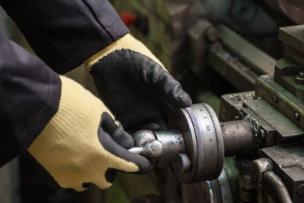As a brand of Saint-Gobain, a world leader in sustainable habitat, Norton offers the widest portfolio of grinding, cutting, blending, finishing and polishing solutions for all markets, materials and applications with the most advanced and affordable technology. So, as your needs evolve, our access to the global expertise of Saint-Gobain becomes even more valuable to making a difference in your day-to-day needs. And, we don’t have to look far for more localized expertise with our largest research center located right nearby in Northboro, MA.
Compared to the more common safety hazards confronted by welders, grinding wheels may seem harmless – but caution must be taken.
The job of a welder is often considered dangerous. The fumes created during the welding process can be incredibly hazardous to one’s health, exposure to the UV rays created while welding can result in permanent eye damage, and the arc alone can reach temperatures as high as 10,000 degrees F. But these hazards are well known and are typically avoided because welders understand the dangers involved with their job and, in turn, take the proper precautions to protect themselves.
There are, however, other safety issues that are not as apparent as the extreme heat or fumes coming off the welding gun. Something as innocuous as a grinding wheel can pose just as much of a threat to the operator if the proper precautions aren’t taken.
DAILY GRIND
Grinding wheels are made up of thousands of small abrasive cutting grains that have been bonded together by an organic resin compound, reinforced with fiberglass, and are used in a variety of pre- and post-weld activities. From prepping material to ensure good fit-up to smoothing out a weld to apply a final coat of paint, using a grinding wheel is a typical part of a welder’s daily routine.
Grinding wheels are so common that they have a handful of nicknames, including blades, rocks and stones. But therein lies the danger. When a fragment of anything referred to as blade becomes a projectile, the results can be fatal.
While the jobs they perform allow operators to effectively grind, form and finish the toughest materials, grinding wheels can be incredibly dangerous if they are misused or damaged. That’s why operators need to know what safety precautions to take as well as how to properly use a grinding wheel.
Norton ǀ Saint-Gobain Abrasives has a product safety department with more than 100 years of grinding wheel safety experience and information. In fact, the precursor to the current national safety code for abrasives, American National Standards Institute ANSI B7.1 “Safety Requirements for the Use, Care, and Protection of Abrasive Wheels,” was first developed in 1916 and based on safety information developed by Norton. A new Norton safety resource microsite offers a wide range of resources and a wealth of information to help ensure the safe design, application and use of Norton abrasive products.
SIMPLE STORAGE
Fairly typical conditions such as moisture, extreme temperatures and rough treatment can damage a grinding wheel. The problem is that a damaged wheel can easily go undetected by conventional means, which is why it’s so important for grinding wheels to be properly stored when they aren’t in use and then inspected before they’re put to work each and every time.
Simple rules should be employed for grinding wheel storage. Suitable racks, bins, drawers and boxes are recommended to keep the various types of wheels organized for easy retrieval. And they should be stored in a way that allows for them to be removed without disturbing other wheels. Wheels should also be rotated on a regular basis to minimize the damage that can happen during lengthy periods of unuse. Also, grinding or cutting performance can degrade with time making the work more difficult or time consuming. As a result, there is a recommended shelf life provided by each wheel manufacturer to help assure that these concerns are minimized. Overall, grinding wheels should never be stored where they could be exposed to water, solvents, extreme cold or humid conditions that could cause condensation on the wheels.
The storage and rotation of grinding wheels can and should be incorporated into a regularly scheduled maintenance program.
The maintenance program should also include the grinding tools, as well. The abrasive safety code, ANSI B7.1, recommends that electric grinders are checked monthly and that air-driven or pneumatical portable grinders are checked after 20 hours of use or once per week, whichever comes first. In addition to visually inspecting the wheel, maintenance for the electric and pneumatical grinders includes checking the tool’s speed and pounds per square inch (PSI), respectively.
All test results should be recorded in a log that includes the date and serial number of the grinding tool. Keeping careful records of maintenance promotes proper and consistent maintenance practices and lets users see if and when the speed or PSI of a tool changes over a certain period of time. Before performing any maintenance checks on a tool, be sure to remove the grinding wheel and any loose objects from the spindle.
PROPER PAIRING
Workplace safety always increases when a regular maintenance routine is in place, but even if a grinding tool is in the best possible working condition, safety issues can arise if it is paired with the wrong grinding wheel. The No. 1 rule for pairing a wheel with a tool is to never choose a wheel that’s too big for the tool.
And that means never forcing a grinding wheel to fit onto an undersized tool or removing or altering the guard or mounting flanges to try to get an oversized wheel to fit. Always use a wheel and grinding tool as they were intended to be used – a 7-in. wheel on a tool designed to be used with 7-in. wheels and a 4.5-in. wheel on a tool designed to be used with 4.5-in. wheels. Never use a grinder without the guard and auxiliary handle. These are critical safety components that are provided with each tool and should always be used. If the guard or handle get in the way, then use a different tool that allows easier access. The operator is taking their life in their own hands if they use a grinder without a guard.
Before mounting a grinding wheel, check the speed of the grinding tool and make sure the wheel is designed to operate at the same speed or higher than the tool’s rated speed.
FOLLOW PROCEDURE
Once the proper pairing is chosen, carefully inspect the grinding wheel for damage, such as chipping or cracks, and then be sure to unplug the grinder before removing the old wheel. It’s also good practice to check that the tool is in good working order, including flanges that are clean and in good condition. Four-inch grinders and larger must also be equipped with a side auxiliary handle to allow the operator to maintain control of the tool throughout the entire grinding operation.
After mounting the grinding wheel, the guard on the tool may need to be adjusted accordingly so the guard is between the wheel and the operator. Before starting the grinding operation, however, test the setup in an enclosed area by turning it on and allowing it to run at operating speed for a full minute. If the wheel is damaged, it will most likely break in that first minute, so potential projectiles will be contained in the enclosed area.
When the grinding operation stops, allow the wheel to come to a complete stop and place the grinding tool in a storage rack – even if it’s only for a short period of time. If a tool is set down where it could fall or be bumped, an operator could return to the tool not knowing it has been damaged and that it poses a safety threat. If an operator knows that a tool has been dropped, the wheel must be removed, inspected and discarded if damaged.
Clearly, not all safety concerns can be addressed in this short article. For specific use, care and storage questions, read and review the ANSI B7.1 national safety code, which is specific to abrasive wheels. It is also important that all OSHA regulations regarding abrasive wheels be observed. Last, be sure to read, understand and follow the safety guidelines and symbols that are provided with and printed on every wheel.
Regardless of the frequency in which grinding activities are taking place, it’s critical that operators use a properly guarded grinding tool paired with the right grinding wheel. Additional measures must also be taken, such as inspecting and testing wheels before use and cradling a tool in a storage rack when not in use.
Previously Featured on Norton's Resources page.








Talk to Us!
Leave a reply
Your email address will not be published. Required fields are marked *